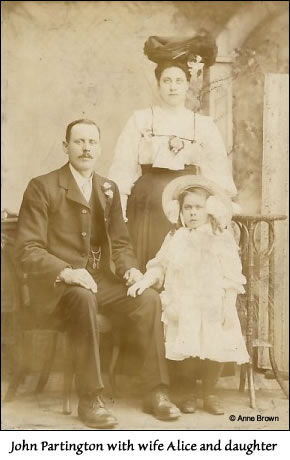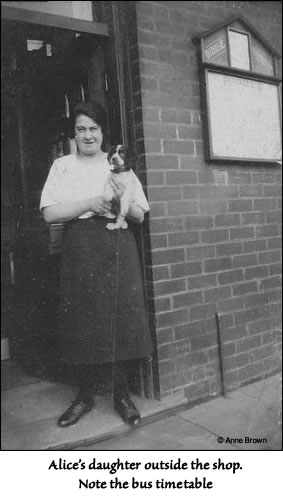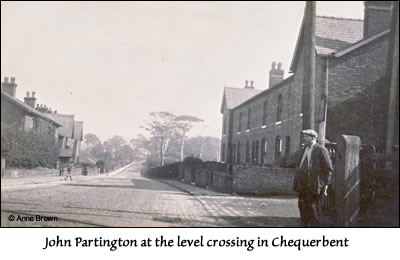My great grandmother, Alice Smith, was born in a small village called Chew Moor in the district of Lostock near Bolton in Lancashire in 1882. Alice was a dairymaid on the family farm and one of thirteen children. The Smiths had been farmers for generations and although times were hard, each child had some formal education, but mainly their learning came from running the farm, learning the business side of farming and utilising the skills they learned.

Alice’s skill was baking and it was this she used in order to supplement her and her new husband’s income after she married John Partington. By 1906 Alice and John had set up home in Chequerbent, a village close to Westhoughton in Lancashire. John was working for the Hulton Colliery Company as a brakesman and they had one small child, my grandmother, but Alice was an industrious lady and keen to add more pennies to the coffers.
Their home on Manchester Road was ideally situated for a new business being sandwiched between a butcher’s shop, a fried fish dealer and a temperance bar (which sold sarsaparilla and Vimto amongst others), and although no shop front was visible, Alice used the front parlour to sell her home-made bread, cakes and pastries.
Alice’s baking was a success in the community and soon she was adding more stock to her home-made range, including eggs, fruit, flour and general groceries. In fact anything that Alice thought she could sell and was asked for in the ‘shop’.
The 1911 census shows Alice and John at Manchester Road, Chequerbent, with John’s occupation as ‘crossing pointsman for a colliery’ and Alice’s as ‘shopkeeper of mixed groceries’.
Alice’s little empire continued to grow and by the early 1920s, she and John had bought the last but one house on the terrace they were living in, and turned a former cobbler’s shop into a grocer’s, lining the walls with wooden shelves and installing a grand mahogany counter resplendent with brass scales, weights and a special glass fronted wall cabinet which contained remedies for ailments.

The shop window was enlarged and a glass shelf display contained pipes and tobacco. Large glass toffee jars were arranged on the counter and around the shop, and packets of crisps with a blue salt bag inside were kept in large tins to keep them as fresh as possible. Under the glass shelf was a rail from which bunches of bananas would hang and a drawer of the counter served as a till, in which a tin of stamps was kept as part of their service along with a postbox situated nearby.
It wasn’t long before Alice bought the house next door and from that front room she sold coal, ironmongery, candles and crockery amongst other items. Husband John meanwhile was still working for the Hulton Colliery, manning the level crossing less than 30 yards away and helping out in the shop when not at work.
The shop carried on trading until my great grandmother’s death in 1936. Her daughters, Alice and Doris, along with their father John continued the business of a very typical corner shop (even to the extent of having the bus timetable on the wall outside the shop), until John`s death in 1952 and my grandmother’s death in 1954. Which is when my great aunt took ownership until her death in 1982 and the shop closed its doors for the last time.
It’s the sweet jars I can remember, when visiting as a child. My brother and I were allowed 2oz each and no more. I don’t ever recall seeing the brass ice-cream wafer maker, but it was there amongst a box of old shop knives, steels and brass weights when I called in one day.

My great aunt had stopped selling ice-cream, cooked meats and cheese and the implements were redundant. In her shed in the back yard I came across it whilst moving some boxes and saw a very grimy wafer maker and picked it up to see what it was made of. My great aunt had spotted me and suggested I take it home and clean it up with some Brasso. This I duly did and it’s a reminder, for me, of a hard-working lady determined to do her best for her family.
Partington’s shop, along with nearby properties, was demolished in 1970 to make way for a motorway and roundabout. The last half dozen houses of the terrace of Manchester Road, including the original shop, still remain today and contain the date stone of 1893 with the name of that section of the terrace, ‘Hilton’s Houses’.
The photo [left] shows John Partington waiting for the colliery train in 1927. John also worked the points as the through (passenger) train also passed over Manchester Road on it’s way to Chequerbent station. Many of the inhabitants of Chequerbent worked in the local pits. One of them was Pretoria Pit in which there was a devastating explosion in 1910, with 344 boys and men lost their lives (See Pretoria Pit Mine Disaster for more details.
Alice and John Partington are buried in the graveyard of St John’s Church, Wingates near Westhoughton, along with their daughter Doris.
My hand-made brass ice-cream wafer maker is just one of my family keepsakes and heirlooms, and triggers off so many memories of times past. I hope this article gives you an insight into how a humble milkmaid made a good life for herself and the generations that followed.
Anne Brown
© Anne Brown 2009